The 1950's Roots of Rock
These are the voices that shaped the genre

Frank Sinatra
Frank Sinatra, known for his jazz and pop influence, played a key role in the development of rock and roll. His vocal style, phrasing, and emotional connection with audiences set a precedent for future rock stars. Sinatra’s mastery of the microphone and stage presence inspired many rock singers. He also embraced new genres and collaborated with jazz musicians, paving the way for musical blending in rock.
Sinatra’s success highlighted the youth market’s power in music, a model that rock and roll later embraced. His focus on singles drove chart success, influencing rock’s rise. His willingness to evolve and explore new sounds also encouraged future rock artists to push musical boundaries, helping shift the industry toward a more dynamic, commercially driven model.

Eddy Fisher
Eddy Fisher, with his smooth tenor voice and charm, played a significant role in shaping the early pop and rock music scene. His popularity in the 1950s helped solidify the importance of strong vocal delivery in mainstream music, influencing later rock singers in their vocal technique and emotional expressiveness. Fisher’s blend of pop ballads and his commercial success demonstrated the power of emotional connection with the audience, a trait that would be vital in rock music. Additionally, his crossover appeal between pop and other genres inspired rock artists to explore a wider range of musical styles, paving the way for the genre’s evolution. His influence helped establish the model of the crooner-style rock vocalist, seen in artists like Elvis Presley and Roy Orbison.

Kay Starr
Kay Starr, known for her powerful voice and versatile style, influenced rock music by helping bridge the gap between pop, jazz, and early rock ‘n’ roll. Her emotive delivery and ability to convey deep emotion in songs influenced rock vocalists, particularly in the way they connected with their audiences. Starr’s adaptability across genres demonstrated the potential for rock musicians to experiment with various musical styles. Her success with both upbeat songs and ballads set a precedent for rock artists to explore a range of emotional tones and musical diversity, paving the way for future rock vocalists to expand their expressive capabilities.
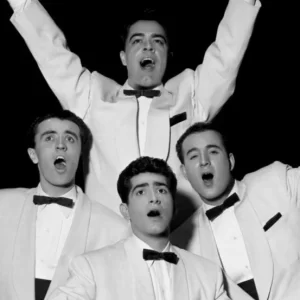
The Four Aces
The Four Aces, known for their smooth vocal harmonies and pop standards, had a significant influence on rock music, especially in shaping the vocal group sound. Their clean, melodic style helped popularize close harmonies, which later became a hallmark of many rock groups, particularly in the 1960s. Their success with ballads also influenced the softer side of rock, contributing to the development of pop rock and folk rock. Additionally, their ability to blend traditional pop with contemporary sounds inspired early rock artists to experiment with vocal arrangements and orchestration, enriching the evolving rock genre.

Percy Faith
Percy Faith’s orchestral arrangements and pop instrumental hits helped shape the musical landscape for rock and roll. His lush style popularized instrumental pop music in the 1950s, with songs like “Theme from A Summer Place” showcasing the emotional power of melody. This created a market for instrumental music, paving the way for rock’s instrumental hits, such as those from The Ventures and Duane Eddy.
Faith’s fusion of classical music with popular styles encouraged rock musicians to experiment with new sounds. His smooth, accessible music bridged traditional pop and rock, while his radio-friendly hits proved the commercial viability of instrumental music, influencing the development of early rock music. His innovations provided a foundation for blending orchestral elements with rock’s raw energy.

Mitch Miller
Mitch Miller, known for his work as a conductor and music producer, had a lasting influence on rock music through his promotion of sing-along and catchy melodies. As a key figure in the development of the 1950s pop sound, he helped shape the vocal harmonies and arrangements that would later influence rock bands. Miller’s focus on strong melodies and accessibility in music set a precedent for rock musicians, who adopted these techniques in creating memorable, radio-friendly hits. His work with artists like Perry Como and Ray Conniff also demonstrated the commercial viability of blending orchestral arrangements with popular music, which rock bands later incorporated into their sound. Additionally, Miller’s encouragement of vocal group performances laid the foundation for the vocal harmonies and collective energy seen in many rock groups.

Patti Page
Patti Page, known for her smooth, versatile voice and successful pop hits, influenced rock music by helping popularize a blend of traditional pop and emerging rock sounds. Her mastery of emotional storytelling through music inspired later rock singers to focus on lyrical expression and vocal delivery. Page’s success with crossover hits like “Tennessee Waltz” showed rock musicians the potential for chart success by blending various genres, including country and pop. Her appeal to a wide audience, including younger listeners, helped shape the commercial viability of music that would influence the development of rock and roll. Additionally, her use of orchestral arrangements in pop songs influenced rock artists to experiment with adding lush instrumentation to their tracks.
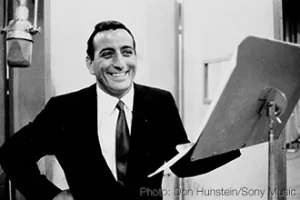
Tony Bennett
Tony Bennett, with his timeless voice and impeccable phrasing, had a significant influence on rock music, especially in terms of vocal technique and emotional delivery. His ability to connect deeply with lyrics and convey emotion inspired many rock singers to approach their performances with a similar depth and authenticity. Bennett’s mastery of jazz, pop, and standards helped rock artists see the value in blending different genres, leading to a more diverse sound in rock music. His success with a wide range of audiences demonstrated the power of strong vocal performance, setting a standard that rock musicians would later embrace. Additionally, his collaborations with other artists encouraged the idea of cross-genre collaborations, a concept that became central to rock’s evolution.
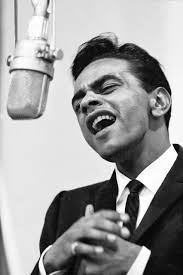
Johnny Mathis
Johnny Mathis, known for his smooth, rich voice and emotive ballads, had a significant influence on rock music by shaping the approach to vocal delivery and romantic lyrics. His ability to convey deep emotion through his voice inspired many rock singers to focus on connecting with their audience on an emotional level. Mathis’s success with ballads helped pave the way for rock artists to explore softer, more introspective themes within their music. His fusion of pop and jazz elements also demonstrated the potential for genre blending, influencing rock musicians to experiment with diverse musical styles. Additionally, his chart success with both singles and albums showed rock artists the importance of crafting a broad appeal, leading to more commercially-minded approaches in rock music.

Jo Stafford
Jo Stafford, known for her clear, expressive voice and mastery of both pop and jazz standards, influenced rock music through her vocal technique and emotional delivery. Her smooth style and ability to convey nuanced emotion in songs inspired many rock vocalists to focus on phrasing and connection with their audience. Stafford’s success in blending traditional pop with jazz elements also encouraged rock musicians to experiment with different genres, fostering a more eclectic approach to sound. Her popularity with both mainstream audiences and music critics demonstrated the commercial power of strong vocal performances, a model that rock artists would later embrace. Additionally, her collaborations with big bands and orchestras showcased the potential for integrating lush arrangements into popular music, a concept later explored in rock music.

Rosemary Clooney
Rosemary Clooney, known for her warm, rich voice and impeccable phrasing, influenced rock music by setting a high standard for vocal performance and emotional depth. Her ability to convey emotion and connect with listeners through ballads inspired many rock singers to focus on vocal expression and storytelling. Clooney’s success with jazz, pop, and standards demonstrated the power of genre blending, encouraging rock artists to experiment with different musical styles. Her commercial success also showed rock musicians the importance of crafting relatable, memorable songs that could appeal to a broad audience. Additionally, her collaborations with big bands and orchestras highlighted the potential for integrating sophisticated arrangements into popular music, influencing rock’s evolving sound.
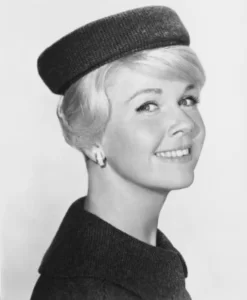
Doris Day
Doris Day, with her clear, vibrant voice and wide appeal, had a significant influence on rock music by shaping the pop vocal style that many rock artists would later adopt. Her ability to convey warmth and charm in her performances inspired rock singers to focus on connecting with their audience emotionally. Day’s success in both upbeat songs and heartfelt ballads demonstrated the versatility that rock vocalists would later embrace. Her smooth blend of pop, jazz, and country elements also encouraged rock musicians to experiment with genre fusion, expanding the sound of popular music. Additionally, her ability to captivate diverse audiences showed rock musicians the importance of mass appeal and commercial success.
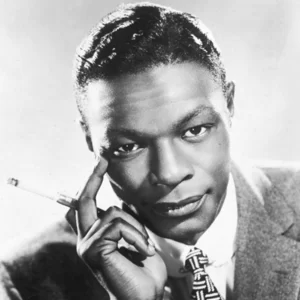
Nat "King" Cole
Nat King Cole, with his smooth voice and mastery of both jazz and pop, had a profound influence on rock music by setting a high standard for vocal delivery and emotional expression. His ability to convey warmth and intimacy in his performances inspired many rock singers to focus on creating personal connections with their audience. Cole’s genre-blending approach, incorporating elements of jazz, pop, and R&B, encouraged rock musicians to experiment with diverse musical styles. His success with both ballads and more upbeat tracks demonstrated the versatility that rock artists would later embrace. Additionally, his pioneering use of the piano as a central instrument in popular music influenced rock musicians to explore different musical textures and arrangements.
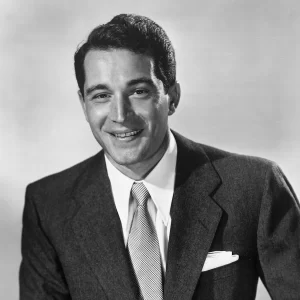
Perry Como
Perry Como, known for his smooth baritone voice and relaxed, crooning style, had a significant influence on rock music by shaping the approach to vocal delivery and emotional connection. His focus on clear, effortless phrasing and sincerity in his performances inspired rock singers to emphasize authenticity and emotional resonance in their vocals. Como’s success with both pop and easy listening music demonstrated the commercial viability of accessible, radio-friendly songs, a model later embraced by rock musicians. His ability to cross over into various genres also encouraged rock artists to experiment with blending styles and reaching wider audiences. Additionally, Como’s relaxed, engaging stage presence set a precedent for rock performers to focus on connecting with fans in a personal, approachable way.